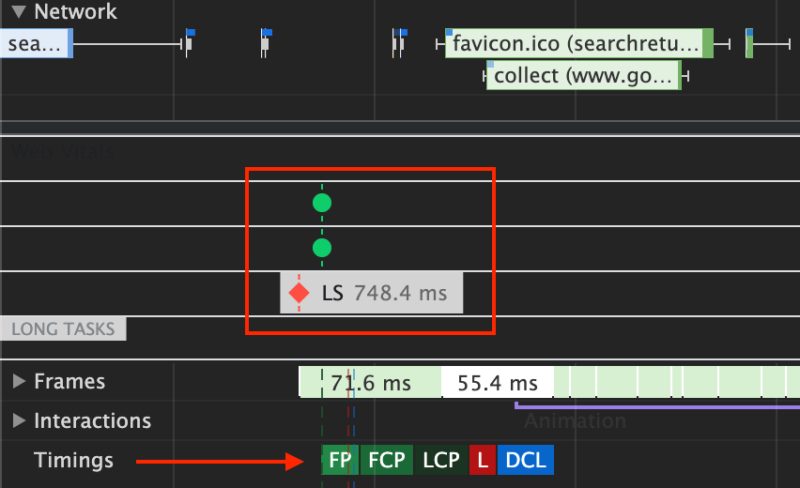Chrome 88 adds to Core Web Vitals DevTools
Chrome 88 allows you to view your site’s LCP, FIP, and CLS data in dev tools.
Developers looking forward to the future Page Experience update. Which adds the relatively new Web Vitals metrics to any pre-existing user experience rating signals, would appreciate the new features in Chrome 88.
Web Vitals track a variety of factors, which are then summed up into three Core Web Vitals scores. Largest Contentful Paint, First Input Delay, and Cumulative Layout Shift. To avoid falling behind more performant peers who may appear above you in Google results. Each of these must be optimized to reach performance (timings) thresholds.
Two new features of note
The first noteworthy change is that Chrome 88 now supports the CSS attribute aspect ratio. Aspect ratio rules allow you to establish ratios for elements that can help you improve Cumulative Layout Shifts in specific situations. Until recently, you could specify either a width or a height HTML property in an image tag, and most browsers will try to fill in the blanks.
To fit the output into a layout system, a designer would do this with changing images, such as those submitted by users. This capability is now available to you as a CSS rule that you can apply to photos and other types of components. This new guideline can help you better create responsive layouts without resorting to hacking percentage dimension calculations to obtain a final layout look, among other things.
Web Vitals lane in Chrome 88 DevTools
Web Vitals now has its own reporting lane in Chrome 88 DevTools. Which is an interesting new feature. While the timed lane flags for these (and a few other) metrics have been available for a while. The new Web Vitals lane has plenty of room for even more extensive reporting.
The Web Vitals lane flags are currently color-coded, with green indicating a passing score and red indicating a failure to meet a good performance level. Hovering your cursor over a specific flag displays the metric name’s acronym as well as the recorded timing in milliseconds. The colors in the timed lane for metrics are not indicative of a score.

Layout Shift (red flag score of 748.4 ms) in the new DevTools Web Vitals reporting lane.
A new lengthy task reporting area can be utilized to line up with main thread events to discover which scripts are being assessed, allowing you to troubleshoot whether the code can be optimized or eliminated.

Navigate to the Performance tab and choose the associated Checkbox to add the new Web Vitals lane to DevTools. You can do this even after the reporting data has been collected if you run a report before selecting the checkbox, and when you restart Chrome, it will remember where you left the checkbox after the last recording.

Web Vitals checkbox in the Chrome DevTools Performance tab
Keep in mind that every given score is a summarization of other metrics. To figure out what’s causing the problem, look for behavior preceding or aligning up with a failing score milestone. The Network and CPU reporting lanes may be able to assist you in determining what it is. You can come across references to render-blocking scripts that you can assess, as well as image loading events where you can compress or resize them.
Cold start performance reports
You’ll need to load a performance report without any assets presently cached in your browser to get the most accurate results. Start a recording and press shift while refreshing the browser page. Which should compel your browser to load all network resources. In DevTools, under the Performance tab, you can also select the reload button. Be aware, though, that the resulting report may not contain everything you desire.
Both points of view are valid. When you use a cold start with an open-ended recording procedure. You may choose when to start collecting data with shift-refresh and when to convert the results into the final report when you click to stop recording. Once your report is loaded. You can use the selection capability to zoom in on and amplify areas of concern throughout the reporting timeline. Chrome also keeps a reported history. Which you can delete when you’re ready to evaluate another page.
No single aspect will elevate your score to number one across the board, as it is with all ranking signals. Keep in mind that even if a website isn’t running well. Its content can still rank well if it’s indexable and of a high enough quality to attract search users. In terms of technical SEO, Core Web Vitals isn’t a guarantee that your material will be indexed. That should serve as a caution that if you’ve got exceptional performance scores. There’s likely to be a lot more to troubleshoot.
Why we should care
The next Page Experience change is causing enough for us to be concerned about our Core Web Vitals scores. We’ve had plenty of time to prepare our websites for the shift, thanks to Google’s foresight. As SEO professionals, we look for whatever advantage we can get to increase our results, and Web Vitals is unquestionably beneficial to both users and search engines.
The post Chrome 88 adds to Core Web Vitals DevTools appeared first on Soft Trending.
from Soft Trending https://ift.tt/3jK1TkN
via softtrending
Comments
Post a Comment